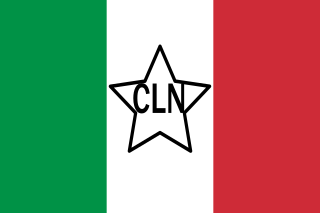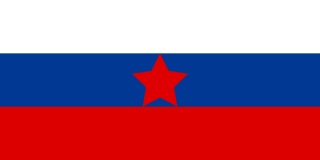
The Italian Resistance consisted of all the Italian resistance groups who fought the occupying forces of Nazi Germany and the fascist collaborationists of the Italian Social Republic during the Second World War in Italy from 1943 to 1945. As a diverse anti-fascist and anti-nazist movement and organisation, the Resistenza opposed Nazi Germany and its Fascist puppet state regime, the Italian Social Republic, which the Germans created following the Nazi German invasion and military occupation of Italy by the Wehrmacht and the Waffen-SS from 8 September 1943 until 25 April 1945.

The Yugoslav Partisans, or the National Liberation Army, officially the National Liberation Army and Partisan Detachments of Yugoslavia, was the communist-led anti-fascist resistance to the Axis powers in occupied Yugoslavia during World War II. Led by Josip Broz Tito, the Partisans are considered to be Europe's most effective anti-Axis resistance movement during World War II.

The Slovene Home Guard was a Slovene anti-Partisan collaborationist militia that operated during the 1943–1945 German occupation of the formerly Italian-annexed Slovene Province of Ljubljana. The Guard consisted of former Village Sentries, part of Italian-sponsored Anti-Communist Volunteer Militia, re-organized under Nazi command after the Italian Armistice of September 1943.

Alojz Gradnik was a Slovenian poet and translator.

The Province of Ljubljana was the central-southern area of Slovenia. In 1941, it was annexed by the Kingdom of Italy, and after 1943 occupied by Nazi Germany. Created on May 3, 1941, it was abolished on May 9, 1945, when the Slovene Partisans and partisans from other parts of Yugoslavia liberated it from the Nazi Operational Zone of the Adriatic Littoral. Its administrative centre was Ljubljana.

Gastone Gambara was an Italian General who participated in World War I and World War II. He excelled during the Italian intervention in favor of the nationalists in the Spanish Civil War. During World War II, he had an outstanding role in the North African campaign and the repression of partisans in Yugoslavia.
The Porzûs massacre was an intra-partisan massacre of the Italian resistance during late World War II, on 7 February 1945. It saw the killings of 17 partisans belonging to the Brigate Osoppo, a strongly Catholic formation, by communist partisans of the Gruppi di Azione Patriottica. Four members of Brigate Osoppo were killed when a group of them was ambushed, while the survivors were taken prisoner and summarily executed in the following days. The event is still the object of study and controversy in Italy.

The Slovene Partisans, formally the National Liberation Army and Partisan Detachments of Slovenia, were part of Europe's most effective anti-Nazi resistance movement led by Yugoslav revolutionary communists during World War II, the Yugoslav Partisans. Since a quarter of Slovene ethnic territory and approximately 327,000 out of total population of 1.3 million Slovenes were subjected to forced Italianization after the end of the First World War, and genocide of the entire Slovene nation was being planned by the Italian fascist authorities, the objective of the movement was the establishment of the state of Slovenes that would include the majority of Slovenes within a socialist Yugoslav federation in the postwar period.

Janko Premrl was a Slovene Partisan.
World War II in the Slovene Lands started in April 1941 and lasted until May 1945. The Slovene Lands were in a unique situation during World War II in Europe. In addition to being trisected, a fate which also befell Greece, Drava Banovina was the only region that experienced a further step—absorption and annexation into neighboring Nazi Germany, Fascist Italy, and Hungary. The Slovene-settled territory was divided largely between Nazi Germany and the Kingdom of Italy, with smaller territories occupied and annexed by Hungary and the Independent State of Croatia.

The Croatian Partisans, officially the National Liberation Movement in Croatia, were part of the anti-fascist National Liberational Movement in the Axis-occupied Yugoslavia which was the most effective anti-Nazi resistance movement. It was led by Yugoslav revolutionary communists during the World War II. NOP was under the leadership of the League of Communists of Yugoslavia (KPJ) and supported by many others, with Croatian Peasant Party members contributing to it significantly. NOP units were able to temporarily or permanently liberate large parts of Croatia from occupying forces. Based on the NOP, the Federal Republic of Croatia was founded as a constituent of the Democratic Federal Yugoslavia.
The Battle of Grčarice was fought in early September 1943 between the Slovene Partisans and the Blue Guard. The battle was waged in Grčarice in German-occupied Yugoslavia, modern-day Slovenia.
Mario Toffanin a.k.a. his nom de guerre "Giacca" was an Italian Communist partisan and responsible for the Porzûs massacre.
The Italian partisan brigades were armed formations involved in the Italian resistance during the World War II.

The Brigate Garibaldi or Garibaldi Brigades were partisan units aligned with the Italian Communist Party active in the armed resistance against both German and Italian fascist forces during World War II.
The Brigate Osoppo-Friuli or Osoppo-Friuli Brigades were autonomous partisan formations founded in the headquarter of the Archbishop Seminary of Udine on 24 December 1943 by partisan volunteers of mixed ideologies, already active in Carnia and Friuli before the Badoglio Proclamation of 8 September. The partisans in this brigade adhered to various and often conflicting ideologies, including both secularism and Catholicism, as well as socialism and liberalism.

The 182nd Armored Infantry Regiment "Garibaldi" is an inactive unit of the Italian Army last based in Sacile in Friuli-Venezia Giulia. The regiment was part of the Italian Army's infantry arm and was last assigned to the Infantry Division "Folgore".

The Race for Trieste, also known as the Trieste Operation, was a battle during the Second World War that took place during early May 1945. It led to a joint allied victory for the Yugoslav Partisans and 2nd New Zealand Division and a joint occupation of Trieste, but relations soon deteriorated and led to a nine-year dispute over the territory of Trieste. This battle is also considered the last battle in which a considerable force of Chetniks fought, as 13,000 of the irregular troops under Momčilo Đujić surrendered to the New Zealand forces under Lieutenant General Sir Bernard Freyberg as the battle progressed.

Emilio Grazioli was an Italian Fascist politician and prefect, High Commissioner for the Province of Ljubljana from 1941 to 1943.

Bruno Coceani, born Bruno Coceancig was an Italian Fascist politician, prefect of Trieste during the Italian Social Republic.














